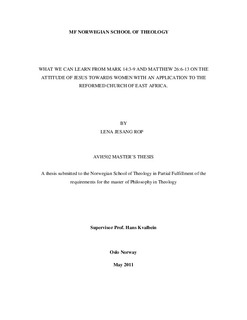What we can learn from Mark 14:3-9 and Matthew 26:6-13 on the attitude of Jesus towards women with an application to the Reformed Church of East Africa
Master thesis
Permanent lenke
http://hdl.handle.net/11250/161008Utgivelsesdato
2011-10-18Metadata
Vis full innførselSamlinger
Sammendrag
As I read through Mark 14:3-9 and Matthew 26:6-13 on the woman who anointed
Jesus was showing some sign of gratitude, humility, and love towards Jesus I began to wonder
how such an understanding would affect the readers understanding of the story and women
therein. I assumed that the authors had specific intention in the way in which they portrayed
these women and wondered what “meaning” anointing they were intending for their audience to
understand. For me the way in which these women are portrayed as prophets, or as disciples
is very important, not only to the stories in which they appear, but to the roles that
women were portrayed as enacting in earlier Christianity and by extension, the roles that are
acceptable for them today.
Therefore, I want to discover all of the possible meaning anointing might have had for
the intended readers of the Mark and Matthew and the other two texts and by so doing, analyze
the possible ways in which these women are being portrayed. The women’s actions can be
4
interpreted in various ways, which I assume will result in multiple possible interpretations from
Mark 14:3-9 and Matthew 26:6-13 and its theological meanings, with varying degrees of
likelihood. Other questions include; how does this implication (of anointing) affect the ways in
which women are viewed in the bible and in reality.
